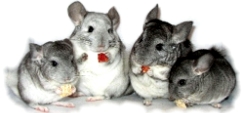
We're not veterinarians and we can't see his tail, that makes it hare to give advice. So, to be on the extra safe side, you may want to get him rechecked by the vet.
Having said that ... here are a few suggestions you may also want to consider in the meantime:
(1) Being scabbed over, is nature's way to protect the open wound from debris and germs ... but ... a wound also needs fresh air to heal. As the scab dries and the skin and wound heals, mother nature guides animals in how to how to care for themselves. An animal will tend to nibble off the scab ever so often, removing the hard scab that is pushing against the tender skin as it heals, giving it a bit of fresh air and allowing drainage of the wound, if needed, then it will scab over again. As the sore heals it causes the skin to itch ... a triple antibiotic ointment can help keep it soft, kill the germs and help keep it from itching so much.
(2) Often a mate or cage mate will help in removing the scab, licking away drainage and removing dead skin, helping the wound to heal ... BUT ... sometimes a chin can be a little over zealest and carry it a bit to the extreme and can make the situation worse ... OR ... the mate or cagemate, while trying to help, may cause a little more pain than the injured chin is willing to tolerated, which can result in a fight ... making a bad situation worse and possibly having to treat two injured chins instead of just one. I tend to keep mine separated until healed completely. Cages close, but at least 4" apart, will usually help keep them in communication with one another. Playtime outside of the cage for both of them at the same time is permissible, as long as they are very, very, very closely supervised, of course.
(3) While a wound is healing, I tend to keep white paper towels or white butcher paper in the bottom of the cage instead of litter and change it a few times during the day ... this will help you more easily see any drainage and/or blood, which would be a signal that you may have more problems in the near future. The sooner you catch a problem, the easier it is to correct.
(4) If Toby is on any antibiotics, he will also need yogurt halfway between the doses of antibiotic, but not at the same time, to help replace the flora in it's digestive tract and keep him from stopping up.
his brother became constipated due to a hair ball
CAUTION: Constipation/impaction/blockage of a chinchilla's digestive system, can mean the death of a chinchilla ... a chinchilla's digestive system MUST continue to work properly, once it can not function properly the chinchilla can go down quickly ... so ...
Petramalt, in the dog and cat section of the pet store, is a good preventative for hair/fur balls. A small amount, about the size of a corneal of corn, once or twice a month is good for them. It comes in a tube.
The signs of constipation and/or dehydration are (1) loss of weight, (2) small dryer poops and fewer of them, (3) loss of appetite and decrease of amount of liquid intake, are all signs to watch for. As it progresses, the outline of the spine is visible. If a chin's system stops or slows, everything backs up and the chinchilla does not eat because he is so full of
it that he/she is does not feel hungry. If he is not hungry, he will not eat .. it's a vicious cycle that can kill a chin within a mater of hours

Jo Ann

 Author
Topic: tail bruising (Read 4269 times)
Author
Topic: tail bruising (Read 4269 times)




